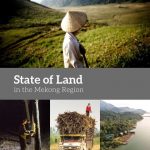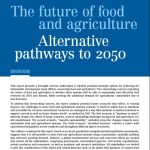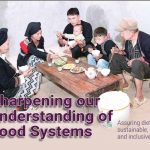
9 downloads
Title of document: State of Land in the Mekong Region – Highlight (Version Khmer) Authors/editor: Micah L. Ingalls, Jean-Christophe Diepart, Nhu Truong, Daniel Hayward, Tony Neil, Chanthavone Phomphakdy, Rasso Bernhard, Sinu Fogarizzu, Michael Epprecht, Vong Nanhthavong, Dang H. Vo, Dzung Nguyen, Phong A. Nguyen, Thatheva Saphangthong, Chanthaviphone Inthavong, Cornelia Hett and Nicholas Tagliarino Journal’s name if any: Ministry/Government Agency/Organisation: CDE, MRLG Year of publication: 2019 Geographic focus: Mekong Regional Main issues / topics addressed (for example: …) School of agroecology (if any): Web address to original document (if any): http://mrlg.org/resources/state-of-land-in-the-mekong-region_hilight_khmer/ Summary: The report “State of Land in the Mekong Region” was launched today in Vientiane, Lao PDR. The first publication of its kind in the Mekong Region, it brings together key data and information on the current status of, and changes in, land resources, their social distribution, and the conditions of governance that shape them. The report stresses the need for urgent action towards transformational change. It was co-produced by the Centre for Development and Environment (CDE) of the University of Bern and the Mekong Region Land Governance Project (MRLG). Funding was provided by Switzerland, Germany, and Luxembourg. The Mekong region – Cambodia, Lao PDR, Myanmar, Thailand, and Vietnam – is in the midst of profound social and environmental change. Despite rapid urbanization, the region remains predominantly rural. More than 60 per cent of its population live in rural areas, and the vast majority of these people are engaged in agriculture. Due to rapid growth of its agricultural sector, the Mekong region has become a global centre of production and trade for commodities such as rubber, rice, cassava, wood, sugar cane, and palm oil. Between 1996 and 2015, overall agricultural land in the Mekong region grew by 20 per cent, or around 9 million hectares. Most of this expansion has occurred at the expense of the region’s natural capital – especially forests and other vegetation. Read More

13 downloads
Title of document: State of Land in the Mekong Region – Highlight (Version Burmese) Authors/editor: Micah L. Ingalls, Jean-Christophe Diepart, Nhu Truong, Daniel Hayward, Tony Neil, Chanthavone Phomphakdy, Rasso Bernhard, Sinu Fogarizzu, Michael Epprecht, Vong Nanhthavong, Dang H. Vo, Dzung Nguyen, Phong A. Nguyen, Thatheva Saphangthong, Chanthaviphone Inthavong, Cornelia Hett and Nicholas Tagliarino Journal’s name if any: Ministry/Government Agency/Organisation: CDE, MRLG Year of publication: 2019 Geographic focus: Mekong Regional Main issues / topics addressed (for example: …) School of agroecology (if any): Web address to original document (if any): http://mrlg.org/resources/3025-2/ Summary: The report “State of Land in the Mekong Region” was launched today in Vientiane, Lao PDR. The first publication of its kind in the Mekong Region, it brings together key data and information on the current status of, and changes in, land resources, their social distribution, and the conditions of governance that shape them. The report stresses the need for urgent action towards transformational change. It was co-produced by the Centre for Development and Environment (CDE) of the University of Bern and the Mekong Region Land Governance Project (MRLG). Funding was provided by Switzerland, Germany, and Luxembourg. The Mekong region – Cambodia, Lao PDR, Myanmar, Thailand, and Vietnam – is in the midst of profound social and environmental change. Despite rapid urbanization, the region remains predominantly rural. More than 60 per cent of its population live in rural areas, and the vast majority of these people are engaged in agriculture. Due to rapid growth of its agricultural sector, the Mekong region has become a global centre of production and trade for commodities such as rubber, rice, cassava, wood, sugar cane, and palm oil. Between 1996 and 2015, overall agricultural land in the Mekong region grew by 20 per cent, or around 9 million hectares. Most of this expansion has occurred at the expense of the region’s natural capital – especially forests and other vegetation. Read More

8 downloads
Title of document: State of Land in the Mekong Region – Highlight (Version Lao) Authors/editor: Micah L. Ingalls, Jean-Christophe Diepart, Nhu Truong, Daniel Hayward, Tony Neil, Chanthavone Phomphakdy, Rasso Bernhard, Sinu Fogarizzu, Michael Epprecht, Vong Nanhthavong, Dang H. Vo, Dzung Nguyen, Phong A. Nguyen, Thatheva Saphangthong, Chanthaviphone Inthavong, Cornelia Hett and Nicholas Tagliarino Journal’s name if any: Ministry/Government Agency/Organisation: CDE, MRLG Year of publication: 2019 Geographic focus: Mekong Regional Main issues / topics addressed (for example: …) School of agroecology (if any): Web address to original document (if any): http://mrlg.org/resources/state-of-land-in-the-mekong-region-highlight_lao/ Summary: The report “State of Land in the Mekong Region” was launched today in Vientiane, Lao PDR. The first publication of its kind in the Mekong Region, it brings together key data and information on the current status of, and changes in, land resources, their social distribution, and the conditions of governance that shape them. The report stresses the need for urgent action towards transformational change. It was co-produced by the Centre for Development and Environment (CDE) of the University of Bern and the Mekong Region Land Governance Project (MRLG). Funding was provided by Switzerland, Germany, and Luxembourg. The Mekong region – Cambodia, Lao PDR, Myanmar, Thailand, and Vietnam – is in the midst of profound social and environmental change. Despite rapid urbanization, the region remains predominantly rural. More than 60 per cent of its population live in rural areas, and the vast majority of these people are engaged in agriculture. Due to rapid growth of its agricultural sector, the Mekong region has become a global centre of production and trade for commodities such as rubber, rice, cassava, wood, sugar cane, and palm oil. Between 1996 and 2015, overall agricultural land in the Mekong region grew by 20 per cent, or around 9 million hectares. Most of this expansion has occurred at the expense of the region’s natural capital – especially forests and other vegetation. Read More

48 downloads
Title of document: State of Land in the Mekong Region – Full report Authors/editor: Micah L. Ingalls, Jean-Christophe Diepart, Nhu Truong, Daniel Hayward, Tony Neil, Chanthavone Phomphakdy, Rasso Bernhard, Sinu Fogarizzu, Michael Epprecht, Vong Nanhthavong, Dang H. Vo, Dzung Nguyen, Phong A. Nguyen, Thatheva Saphangthong, Chanthaviphone Inthavong, Cornelia Hett and Nicholas Tagliarino Journal’s name if any: Ministry/Government Agency/Organisation: CDE, MRLG Year of publication: 2019 Geographic focus: Mekong Regional Main issues / topics addressed (for example: …) School of agroecology (if any): Web address to original document (if any): https://boris.unibe.ch/120285/ Summary: The report “State of Land in the Mekong Region” was launched today in Vientiane, Lao PDR. The first publication of its kind in the Mekong Region, it brings together key data and information on the current status of, and changes in, land resources, their social distribution, and the conditions of governance that shape them. The report stresses the need for urgent action towards transformational change. It was co-produced by the Centre for Development and Environment (CDE) of the University of Bern and the Mekong Region Land Governance Project (MRLG). Funding was provided by Switzerland, Germany, and Luxembourg. The Mekong region – Cambodia, Lao PDR, Myanmar, Thailand, and Vietnam – is in the midst of profound social and environmental change. Despite rapid urbanization, the region remains predominantly rural. More than 60 per cent of its population live in rural areas, and the vast majority of these people are engaged in agriculture. Due to rapid growth of its agricultural sector, the Mekong region has become a global centre of production and trade for commodities such as rubber, rice, cassava, wood, sugar cane, and palm oil. Between 1996 and 2015, overall agricultural land in the Mekong region grew by 20 per cent, or around 9 million hectares. Most of this expansion has occurred at the expense of the region’s natural capital – especially forests and other vegetation. Read More

5 downloads
Title of document: State of Land in the Mekong Region – Brief Authors/editor: Micah L. Ingalls, Jean-Christophe Diepart, Nhu Truong, Daniel Hayward, Tony Neil, Chanthavone Phomphakdy, Rasso Bernhard, Sinu Fogarizzu, Michael Epprecht, Vong Nanhthavong, Dang H. Vo, Dzung Nguyen, Phong A. Nguyen, Thatheva Saphangthong, Chanthaviphone Inthavong, Cornelia Hett and Nicholas Tagliarino Journal’s name if any: Ministry/Government Agency/Organisation: CDE, MRLG Year of publication: 2019 Geographic focus: Mekong Regional Main issues / topics addressed (for example: …) School of agroecology (if any): Web address to original document (if any): http://mrlg.org/resources/mekong-state-of-land-brief/ Summary: The report “State of Land in the Mekong Region” was launched today in Vientiane, Lao PDR. The first publication of its kind in the Mekong Region, it brings together key data and information on the current status of, and changes in, land resources, their social distribution, and the conditions of governance that shape them. The report stresses the need for urgent action towards transformational change. It was co-produced by the Centre for Development and Environment (CDE) of the University of Bern and the Mekong Region Land Governance Project (MRLG). Funding was provided by Switzerland, Germany, and Luxembourg. The Mekong region – Cambodia, Lao PDR, Myanmar, Thailand, and Vietnam – is in the midst of profound social and environmental change. Despite rapid urbanization, the region remains predominantly rural. More than 60 per cent of its population live in rural areas, and the vast majority of these people are engaged in agriculture. Due to rapid growth of its agricultural sector, the Mekong region has become a global centre of production and trade for commodities such as rubber, rice, cassava, wood, sugar cane, and palm oil. Between 1996 and 2015, overall agricultural land in the Mekong region grew by 20 per cent, or around 9 million hectares. Most of this expansion has occurred at the expense of the region’s natural capital – especially forests and other vegetation Read More

18 downloads
Title of document: Position paper: Strengthening agroecology for a fundamental Transformation of agri-food systems Authors/editor: Heinrich Böll Foundation Journal’s name if any: Ministry/Government Agency/Organisation: Heinrich Böll Foundation Year of publication: 2019 Geographic focus: Germany Main issues / topics addressed (for example: Together for nature-oriented family farms and mutually supporting communities; Agroecology as an alternative to industrial farming; Exploiting the potential of agroecology…) School of agroecology (if any): Web address to original document (if any): Summary: The negative effects of industrial agriculture have long been clear, and agroecology offers a multitude of solutions for the fundamental transformation of the agri-food system. The position paper presents these solutions and is supported by the World Future Council and many other important actors of the agroecology debate. Read More

12 downloads
Title of document: The future Alternative pathways to 2050 of food and agriculture – Summary Authors/editor: FAO Journal’s name if any: Ministry/Government Agency/Organisation: FAO Year of publication: 2018 Geographic focus: Global level Main issues / topics addressed (for example: Overview of the future of food and agriculture Alternative pathways to 2050…) School of agroecology (if any): Web address to original document (if any): Summary: This report presents a foresight exercise undertaken to identify potential strategic options for achieving the Sustainable Development Goals (SDGs) concerning food and agriculture.1 The overarching concern regarding the future of food and agriculture is whether these systems will be able to sustainably and effectively feed everyone by 2050 and beyond, while meeting the additional demand for agricultural commodities due to non-food uses. Read More

10 downloads
Title of document: The future Alternative pathways to 2050 of food and agriculture - Full report Authors/editor: FAO Journal’s name if any: Ministry/Government Agency/Organisation: FAO Year of publication: 2018 Geographic focus: Global level Main issues / topics addressed (for example: Challenges ahead for food and agriculture; Looking into the future: scenarios for food and agriculture; Scenario drivers: alternative assumptions for the future…) School of agroecology (if any): Web address to original document (if any): Summary: This report explores different future pathways for food and agriculture systems through three distinct scenarios characterized by the way the key challenges to food security, nutrition and sustainability are dealt with: boldly, partially or not at all. It improves our ex ante understanding of alternative future long-term trends, both globally and at the regional level, of key variables and indicators affecting the future of food and agriculture. On the basis of these findings, the report highlights possible strategic options to guide food and agricultural systems along a more socially, environmentally and economically sustainable path. This report shows convincingly, on the basis of quantitative evidence, that we can achieve more with less, and produce safe and nutritious food for all, while containing the expansion of agricultural sectors and hence limit the use of natural resources. Read More

14 downloads
Title of document: The state of the world’s biodiversity for food and agriculture Authors/editor: J. Bélanger & D. Pilling (eds.). Journal’s name if any: Ministry/Government Agency/Organisation: FAO Year of publication: 2019 Geographic focus: Global level Main issues / topics addressed (for example: Overview; drivers, status and trends; state of management; enabling frameworks; Conclusions…) School of agroecology (if any): Web address to original document (if any): http://www.fao.org/3/CA3129EN/CA3129EN.pdf Summary: This report presents the first global assessment of biodiversity for food and agriculture (BFA). It complements other global assessments prepared under the auspices of the Commission on Genetic Resources for Food and Agriculture, which have focused on the state of genetic resources within particular sectors of food and agriculture. The State of the World’s Biodiversity for Food and Agriculture provides an assessment of biodiversity for food and agriculture (BFA) and its management worldwide, drawing on information provided in 91 country reports (prepared by over 1300 contributors), 27reportsfrom international organizations and inputs from over 175 authors and reviewers.It describes the many contributions that BFA makes to food security and nutrition, livelihoods, the resilience of production systems, the sustainable intensification of food production and the supply of multiple ecosystem services; the major drivers of change affecting BFA; the status and trends of various components of BFA; the state of management of BFA; the state of policies, institutions and capacities that support the sustainable use and conservation of BFA; and needs and challenges in the management of BFA. Read More

34 downloads
Title of document: Sharpening our understanding of Food Systems Authors/editor: CIAT-IIRR Journal’s name if any: Ministry/Government Agency/Organisation: CIAT-IIRR Year of publication: 2019 Geographic focus: Vietnam Main issues / topics addressed (for example: Food Systems Primer in Vietnam…) School of agroecology (if any): Web address to original document (if any): Summary: This Primer on Food Systems provides basic elements to introduce the reader to key principles and concepts of Food Systems approaches. This is an introductory booklet relying on secondary sources of information. Full references are provided at the end of this primer. Read More

 Asia & Mekong Region
Asia & Mekong Region  Cambodia
Cambodia  Laos
Laos  Myanmar
Myanmar  Other
Other  Vietnam
Vietnam